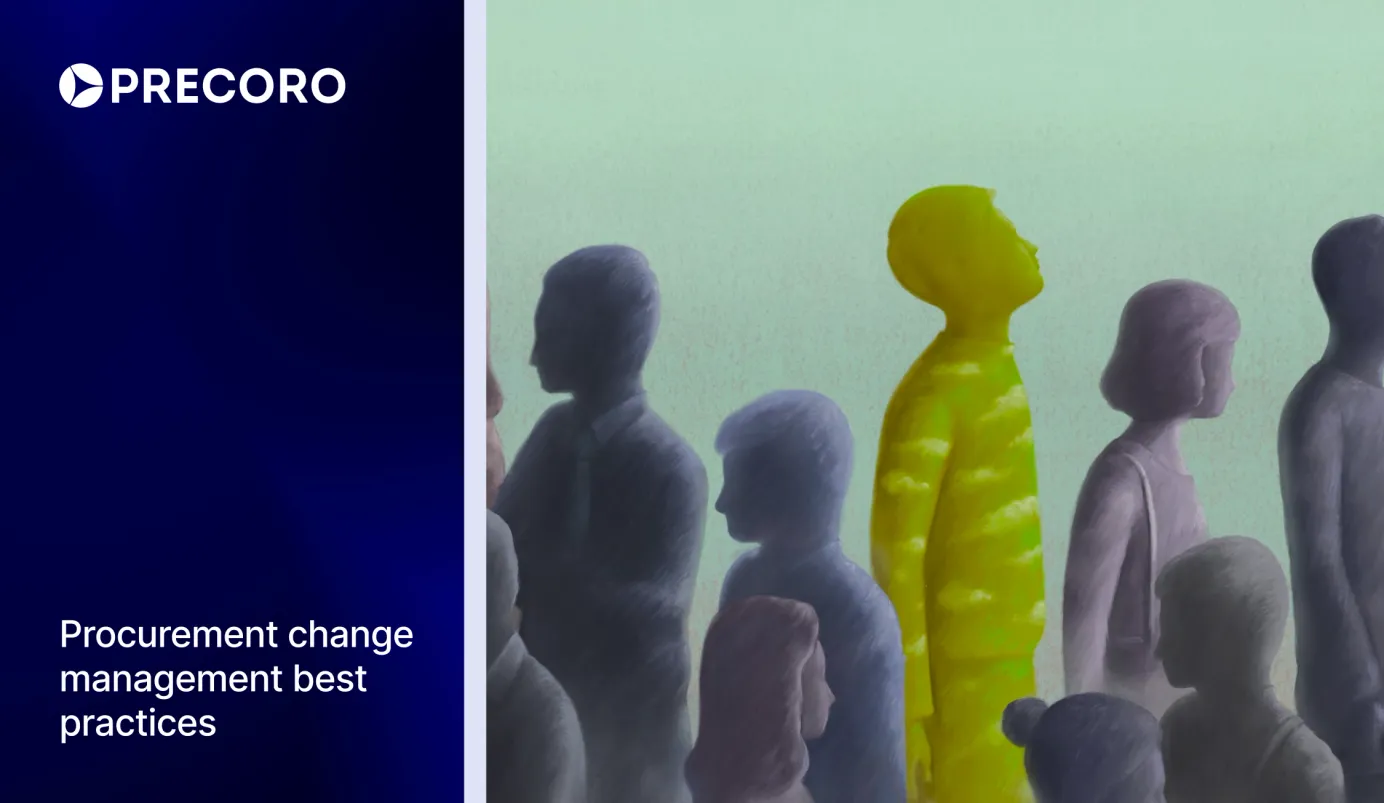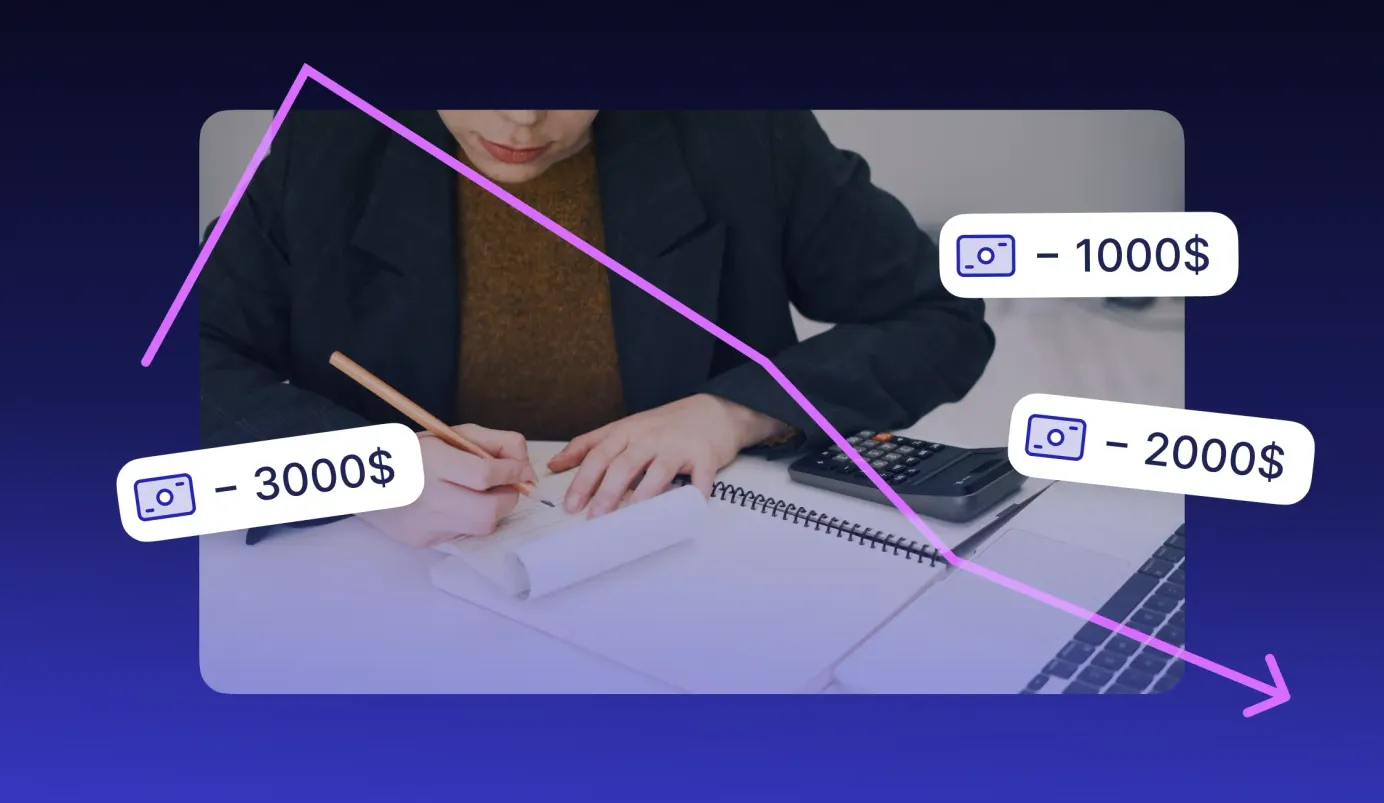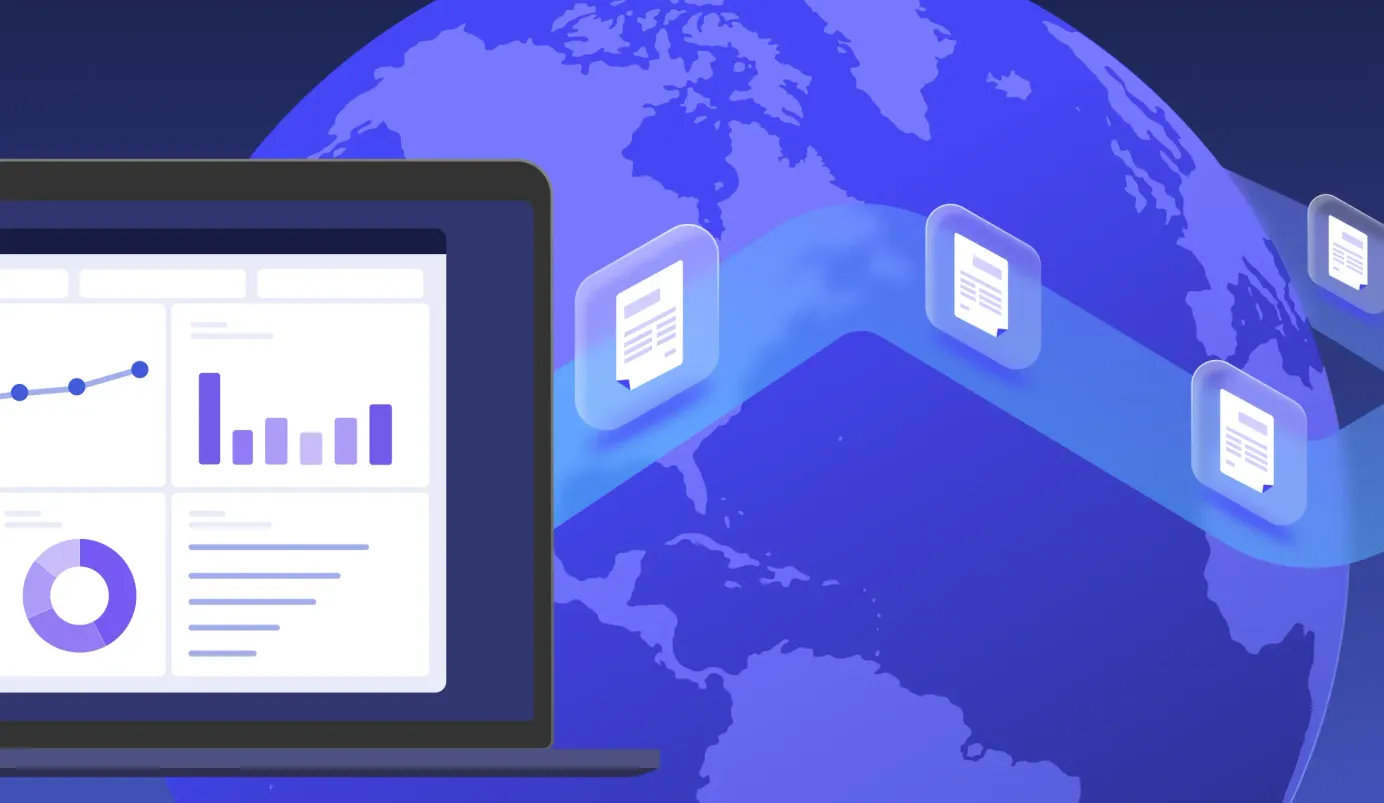
17 min read
Centralized Purchasing System: Key Benefits and Effective Strategies
Learn all you need to know about centralized procurement and how it can benefit your company.
Centralized procurement is a strategy in which a single, dedicated team or department oversees all purchasing across an organization to reduce costs and improve efficiency. By consolidating procurement activities, the organization can leverage bulk buying for stronger negotiating power, standardize processes, ensure policy compliance, and strengthen supplier relationships.
While this approach can deliver substantial savings, one potential drawback is that a uniform system may not always meet the specific needs of individual departments or locations. Let's delve into the topic.
Here's all you need to know:
- What is centralized purchasing?
- Signs your company needs a centralized purchasing system
- Key benefits of centralized procurement
- How to efficiently implement centralized procurement
- Frequently Asked Questions
What is centralized purchasing?
Centralized purchasing is a strategy in which one department or team handles all procurement for the entire organization. By consolidating buying activities, it helps achieve economies of scale through bulk purchasing, enforce standardized processes, improve cost control, and streamline vendor management.
When companies start growing — adding new departments and branches or even expanding to new regions — keeping a handle on purchasing operations gets tricky. That’s when a centralized procurement organization structure proves beneficial.
What is centralized purchasing? It’s a procurement model in which a single, central team — typically at the corporate level — takes responsibility for overseeing the entire purchasing process. This team controls what’s bought, from where, and at what cost for the entire organization.
By operating through a centralized purchasing system, procurement managers can see the big picture, avoid duplicate orders, and score better deals with suppliers through bulk buying. These benefits aren’t just about lower purchasing prices; they’re also about reducing transportation and inventory costs, which can really add up over time.
Here’s how the centralized procurement process works step-by-step:
1. Employees from various departments and subsidiaries request new purchases
Employees across the company submit their requests for new purchases. For example, the marketing team might need new office supplies, the IT department might need laptops, and the logistics team might require equipment. They all submit their purchase requisitions, often with requisition numbers through the specialized centralized purchasing software that helps keep everything organized in one place.
2. Department managers review and approve purchase requisitions
Once the requests come in, they don’t just get placed right away — they go through an approval process. Department heads or managers review them to ensure each purchase is necessary and within budget. With a centralized purchasing system, the approval process can be automated, with requests routed directly to the right people and notifications sent out as soon as the request status changes.
3. The procurement team takes over
Once the department head or manager approves a new purchase, the procurement team steps in to handle everything else. They may also need to double-check and approve the purchase requisition, especially for large orders.
When the approval stage is completed, the procurement team checks their catalog for the trusted suppliers who can deliver required goods or services. If the procurement team needs to search for a new supplier, they create a a request-for-proposal (RFP), outlining the company’s needs and inviting suppliers or vendors to submit their bids.
Some centralized purchasing software solutions like Precoro cover the RFP process. This functionality allows procurement managers to review and compare supplier responses in a single system.
After selecting the best option, the procurement team works to negotiate pricing, discounts, and long-term terms. When the deal is finalized, they place the order, making sure all the details like item descriptions, quantities, and delivery timeframes are right.
4. Getting the goods to the right place
The next step is in the hands of the logistics team. The procurement department works with inventory and logistics teams to ensure that all the ordered goods end up in the right place without delays or discrepancies.
5. Checking the goods when they arrive
Once the goods arrive, someone at the receiving end — either at the warehouse or the department that requested the items — inspects them. They check that everything is in the right condition and that there are no discrepancies between what had been ordered and what was delivered.
6. Invoice processing and payment
After the delivery, the accounts payable team handles the invoice. They perform three-way matching between the order, the goods received, and the invoice to make sure everything lines up and the costs are correct. Then the AP team processes the payment to the supplier, ensuring it’s timely and accurate.
7. Monitoring supplier performance
The procurement team's work doesn’t just stop once the order is placed. They also continuously track supplier performance. Procurement managers monitor whether suppliers deliver on time, if the products are of good quality, and whether the costs stay in line with what was agreed upon. This helps the team adjust future contracts, ensuring that the suppliers meet expectations consistently across the company.
8. Analyzing spending across departments and subsidiaries
With a centralized purchasing system, the procurement team doesn’t just handle purchases — they gain a complete view of spending across all departments and subsidiaries. This visibility allows them to analyze spending regularly, pinpoint areas where costs are increasing, and uncover inefficiencies.
By comparing similar purchases across departments, the procurement team can spot price discrepancies and take advantage of bulk buying to secure better deals. This step plays a key role in making procurement more strategic and cost-effective.
Now that we’ve covered what centralized purchasing is, let’s take a look at when companies might consider adopting it to streamline their operations.
Signs your company needs a centralized purchasing system
Some organizations stick to a decentralized model, where each department or even individual handles their own purchasing. While this approach allows for quicker decisions, the company sacrifices broader control over spending, has to face fragmented processes, and misses out on cost-saving opportunities.
Decentralized procurement becomes especially inefficient as companies grow, making it difficult for upper management to oversee the operations of new departments and offices. The challenges intensify after a merger, when aligning purchasing practices across the organization is essential for maintaining cost control and operational efficiency. Here’s when you know for sure it’s time to consider a centralized procurement organization structure:
Constant confusion in purchasing data
When every department or subsidiary handles its own purchasing, it often results in a patchwork of different systems, methods, and records, each with its own way of logging purchases and expenses. The result? Data that’s inconsistent, incomplete, or hard to interpret.
This chaos can make it nearly impossible to get an accurate view of company-wide spending. Even simple questions — like how much was spent on office supplies last quarter — become tough to answer because of fragmented and inconsistent data.
Additionally, the same item might be purchased at different prices across departments, or there could be duplicate orders because one team isn’t aware that the other one has already placed a similar order. Such mix-ups don’t just make reporting a hassle; they also lead to overspending and overstocking.
Inability to secure cost savings
If ensuring cost savings feels like an uphill battle, or if you’re seeing overspending creep up, a centralized purchasing system might be the solution. When purchasing is spread across different departments or locations, it’s easy for things to slip through the cracks. Without a centralized overview, you’re more likely to miss out on bulk discounts, buy unnecessary items, or repeat orders.
A centralized approach helps you keep a tight grip on costs. By funneling all direct and indirect purchases through one system, you can negotiate better deals, consolidate orders, and track spending more effectively. This means you can identify and stop overspending before it becomes a pattern, while also securing savings from better supplier relationships and smarter purchasing decisions.
Lack of transparency and accountability
Decentralized procurement leaves room for maverick spending, where departments bypass approved suppliers or agreements, driving up costs and reducing the leverage of negotiated contracts. And when things go wrong, it’s hard to trace the purchases and ensure accountability, complicating issue resolution and eroding trust within the organization.
From a compliance perspective, limited transparency can also increase risks. Without a centralized purchasing system, it’s hard for a procurement team to spot issues like non-compliant suppliers or unauthorized purchases. This lack of control can disrupt the supply chain by relying on unreliable vendors, expose the company to fraud through unchecked invoices, and even result in fines for violating regulations.
No strategic procurement — just transactional relationships
When supplier relationships are purely transactional, which is often the case with decentralized procurement, they’re limited to one-off purchases or short-term agreements. Without a strategic approach, companies may end up hopping from one supplier to another, always looking for the lowest price on individual transactions. That’s why the companies often lose out on benefits that come from stronger partnerships — like volume discounts, priority service, or dedicated account support.
Furthermore, this pay-as-you-go dynamic prevents suppliers from fully understanding your business’s needs and growth plans. Without a deeper commitment, it’s challenging for suppliers to align with your operational goals or offer insights that could lead to process improvements, price reductions, or innovations tailored to your requirements.
Stock management issues
When each department handles its own stock and inventory, it’s common for branches in different locations to order similar items without knowing what others have on their hands. That means doubling up on items and wasting money. Meanwhile, other departments may run out of budget and scramble to cover their actual needs.
Moreover, it’s hard to forecast future demand because there’s no centralized view of what’s been ordered, what’s in stock, or what’s needed. This makes it challenging to plan ahead for seasonal needs, new projects, or expected spikes in demand, resulting in either overbuying or underbuying.
No unified approach to sustainability
Without a centralized purchasing system, sustainability demands can easily be overseen. When each department or entity handles its own purchases, it’s hard to ensure that all buying decisions align with your company's ESG goals.
This lack of coordination means that different departments might be sourcing from suppliers that don’t follow sustainable practices or social responsibility standards. Worse yet, your company could be completely overlooking eco-friendly options simply because they aren’t on anyone’s radar at the local level.
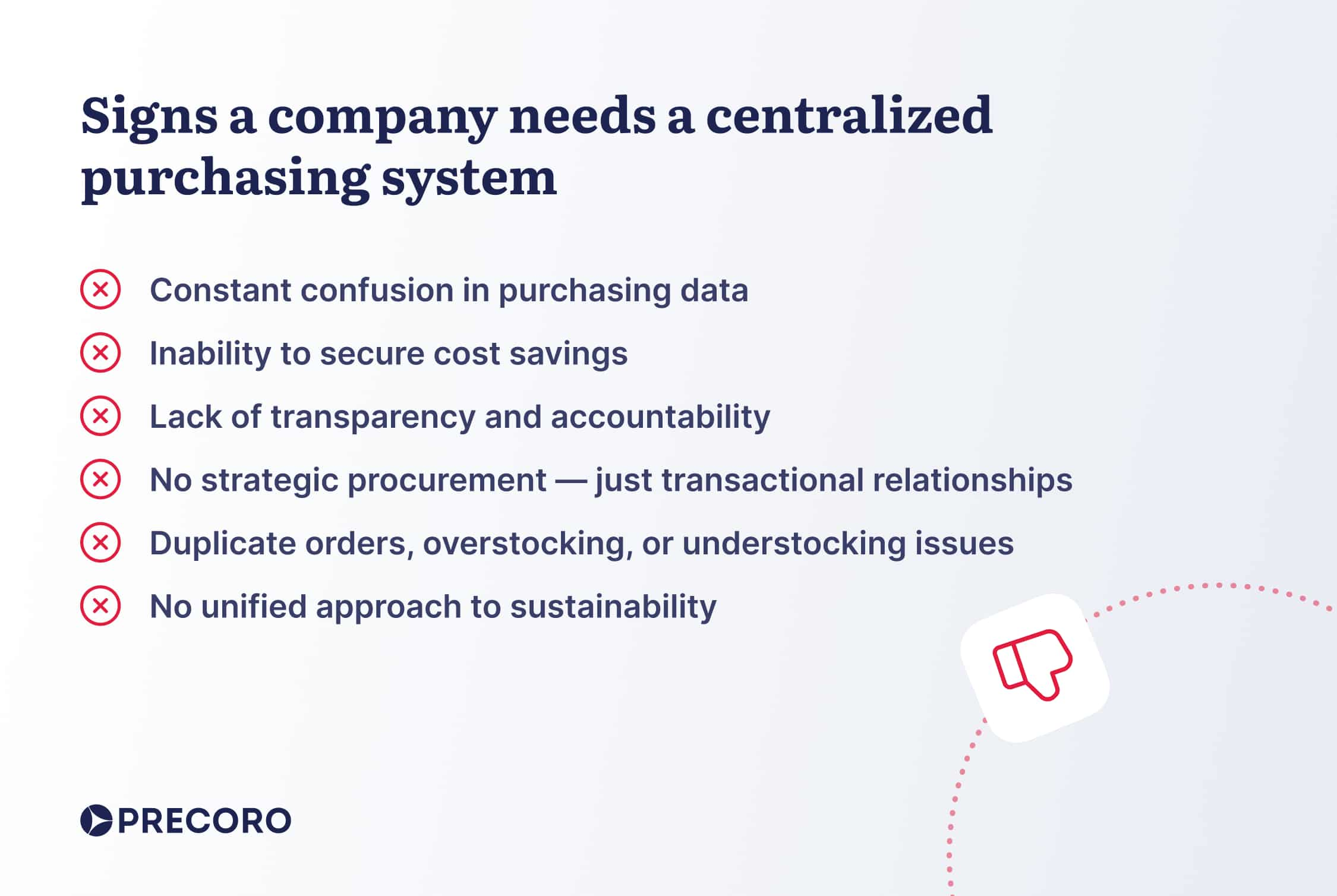
Key benefits of centralized procurement
A centralized procurement model isn’t a fancy buzzword. It’s a practical way for your company to ensure better control over procurement by bringing all your purchasing processes into one place. Here’s a quick overview of the key perks:
Total visibility and control
A centralized purchasing system puts you in the driver’s seat with full visibility and control over everything your company buys and every supplier interaction. No more hunting down information in different subsidiaries or worrying about whether a department forgot to follow the right process. With everything in one place, you can see what’s being ordered, when, at what price, and from whom — all in real time.
For example, if a department orders the same items as another one, you’ll know right away and can avoid duplicate orders or negotiate bulk discounts with one preferred vendor. Such visibility also lets you track supplier performance, so you can make sure you’re getting the best service and quality at a good price, every time.
Overhead expense reduction
A centralized purchasing system significantly reduces unnecessary overhead costs that tend to pile up when each department operates in isolation. Instead, one procurement department can manage everything in centralized purchasing software for optimal employee count, quicker purchase approvals, and fewer errors in procurement documents.
Fewer employees involved in the centralized procurement process directly reduce your overhead expenses. You’re able to achieve the same (or even better) results with a leaner, more efficient system.
Stronger supplier relationships
Here’s one more kicker of centralized procurement: when you consolidate purchases across the company, you’re buying in bulk. That means more bargaining power with suppliers. You’ll have a higher chance to get better pricing, discounts, and more flexible terms with your go-to vendors. It’s a win-win for everyone, and you’ll build stronger, long-lasting partnerships with suppliers by giving them consistent business.
Full compliance
A centralized purchasing system ensures that everyone is following the same rules, making it much easier to keep things consistent and compliant company-wide. No more guessing whether a new supplier meets your company’s requirements or whether the proper managerial approvals were obtained. All purchases are tracked in one centralized purchasing software, and procurement policies are applied automatically at every step — from sourcing and order approvals to payment.
In terms of compliance, a centralized procurement process also helps ensure that the organization is always on the right side of the law. With centralized tracking, you can easily monitor and audit purchases to make sure you’re following all relevant regulations, like those around ethical sourcing, sustainability, or tax laws. This reduces the risk of costly fines or damage to your company's reputation.
Better coordination within the organization
When all procurement data is in one centralized purchasing system, different teams can easily access the information they need, whether it’s about orders, inventory, or budget updates. This shared visibility helps prevent miscommunication and ensures everyone is on the same page.
For example, in a centralized procurement system, requesters from different departments can view the status of their requisitions, the finance team can quickly check on procurement spending, and the inventory team can see which items are in stock or need to be ordered.
This transparency reduces frustration, as departments no longer have to chase down information from one another. It also fosters a sense of teamwork, as everyone is working with the same up-to-date information.
Increased cost savings
Better cost control and opportunities for savings are other benefits of centralized procurement. By consolidating orders, you can negotiate better prices and discounts from suppliers. Additionally, you’ll stop rogue spending, like unapproved orders that come with inflated prices or from unvetted suppliers. On top of that, you can avoid mistakes that require costly corrections, like overbuying inventory or spending lots of money on low-value purchases or tail spend.
Boosted process efficiency
You know how annoying manual tasks can be — repetitive data entry, time-consuming approvals, and constant back-and-forth communication to determine the order status. With centralized purchasing software, a lot of that stuff gets automated. Requests get approved faster, order statuses are visible in the system, invoices get matched automatically, and the whole process just runs more smoothly — especially with a tool that offers AI capabilities.
Additionally, a centralized procurement system helps to cut down on errors, save time, and get rid of bottlenecks that slow everything down. Ultimately, it frees up your team to focus on more strategic work like negotiating better terms with suppliers or analyzing spending across the company instead of chasing down paper trails.
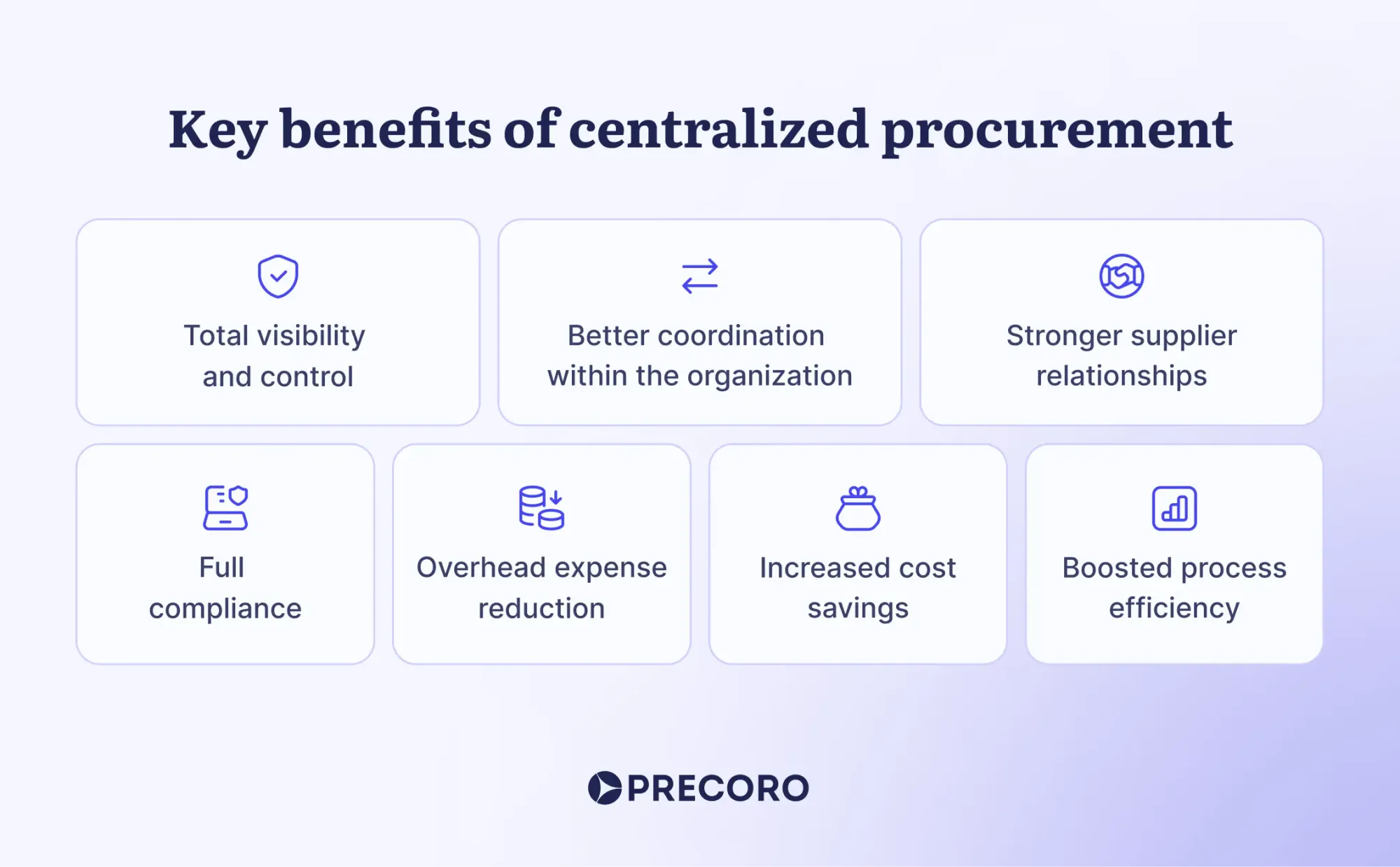
How to efficiently implement centralized procurement
Alright, let’s say you’ve decided a centralized procurement model is the way to go, what’s next? Here’s a step-by-step strategy to make the transition smooth:
1. Take a good look at the current process
Before you can improve, you’ve got to know what’s working and what’s not. Take some time to check out how things are running right now. Is the company facing overspending but can’t identify its source? Is data scattered across departments, making you feel like you’re chasing your tail? Understanding where things break down helps you know exactly where the centralized purchasing system needs to shine.
2. Determine your goals
What’s your ultimate goal with implementing a centralized procurement system? Are you looking to save money, speed up processes, cut the number of suppliers you deal with, or just keep everything under control? Whatever it is, get specific. If you know what success looks like, you’ll have a way better shot at actually hitting it.
This is where setting measurable goals becomes essential. You want to track your progress and improvements by introducing the centralized procurement organization structure, right? So, establish the right metrics and KPIs (Key Performance Indicators) to ensure you’re on the right path, like:
- Purchase order cycle time (how long it takes to get from purchase request to payment)
- Cost savings (how much you’re saving after consolidating orders, eliminating maverick spending, and negotiating better deals)
- Compliance rate (how many purchases are compliant with your internal policies and legal requirements)
- Spend under management (how much of procurement spending happens under the control of procurement managers)
3. Get everyone onboard
Implementing a centralized procurement model isn’t just a procurement thing — you need all departments on the same page. Finance, IT, procurement, the C-suite, and even your suppliers should know what's coming. When everyone’s pulling in the same direction, it’s a lot easier to avoid bumps on the road. Plus, this way, no one’s surprised when the new centralized purchasing system is rolled out.
When implementing a new procurement model, it’s natural to encounter some resistance. That’s why clear communication is crucial. Start by explaining why you’re making the change and how it aligns with the company’s overall goals. When all stakeholders understand the bigger picture, they’re more likely to get on board.
Next, highlight the specific benefits of centralized procurement for each team. For example, finance will have clearer spending reports and real-time expense tracking, enabling faster decision-making, while other departments will enjoy an easier process for submitting requests and tracking orders in real time. Ultimately, emphasize how the new centralized purchasing system will reduce workloads and simplify the process of acquiring goods and services.
4. Choose the right centralized purchasing software
A centralized procurement system is the heart of the transition, so it better work like a charm. Look for a solution that automates as much as possible. You want something that’ll save your team time, not create more busywork. Here’s what to keep an eye out for:
- Multi-entity management
Managing all locations from a single account helps control purchasing activities across all your subsidiaries without the chaos of juggling separate systems. - Integrations with your ERP and accounting systems
Integrating procurement software seamlessly with your ERP and accounting systems helps to eliminate the hassle of repetitive manual data entry. If centralized purchasing software doesn’t have a built-in integration with a system you need, see if it offers an option for your team to set it up through an API. - Compliance with international security standards
A centralized purchasing system with built-in security features ensures your sensitive financial data is protected. Some of the global security standards and regulations you might want to pay attention to are GDPR, CCPA, and SOC2. - Reliable customer support
If the customer support team is quick to reply and can set everything up for you, that’s a big win for a smooth start. Also, make sure they offer training and helpful resources so your team can get up to speed fast without pulling their hair out. - Customizable, automated approval workflows
Being able to set up multi-step approval workflows in a centralized purchasing system means you can tailor the process to suit different needs of everyone involved. Customization allows your teams to create approval processes that align with your company’s specific requirements, whether those approvals depend on purchase size or department-specific rules. - Real-time budget tracking
Real-time budget tracking means no more unexpected expenses that throw off your financial planning. Additionally, prioritize a centralized procurement system that showcases the available budget as you approve purchases. - Comprehensive reporting
Comprehensive reporting gives you quick access to key insights about procurement documents, suppliers, and expenses. Procurement analysis helps make data-driven decisions and spot areas where you can improve processes or save money. - A mobile app
Having a mobile app means your employees can handle requests while they’re on the go, reducing downtime.
If you’re after a centralized purchasing system that checks all the boxes, take a closer look at Precoro. We’re all about making procurement centralization and automation as smooth as possible.

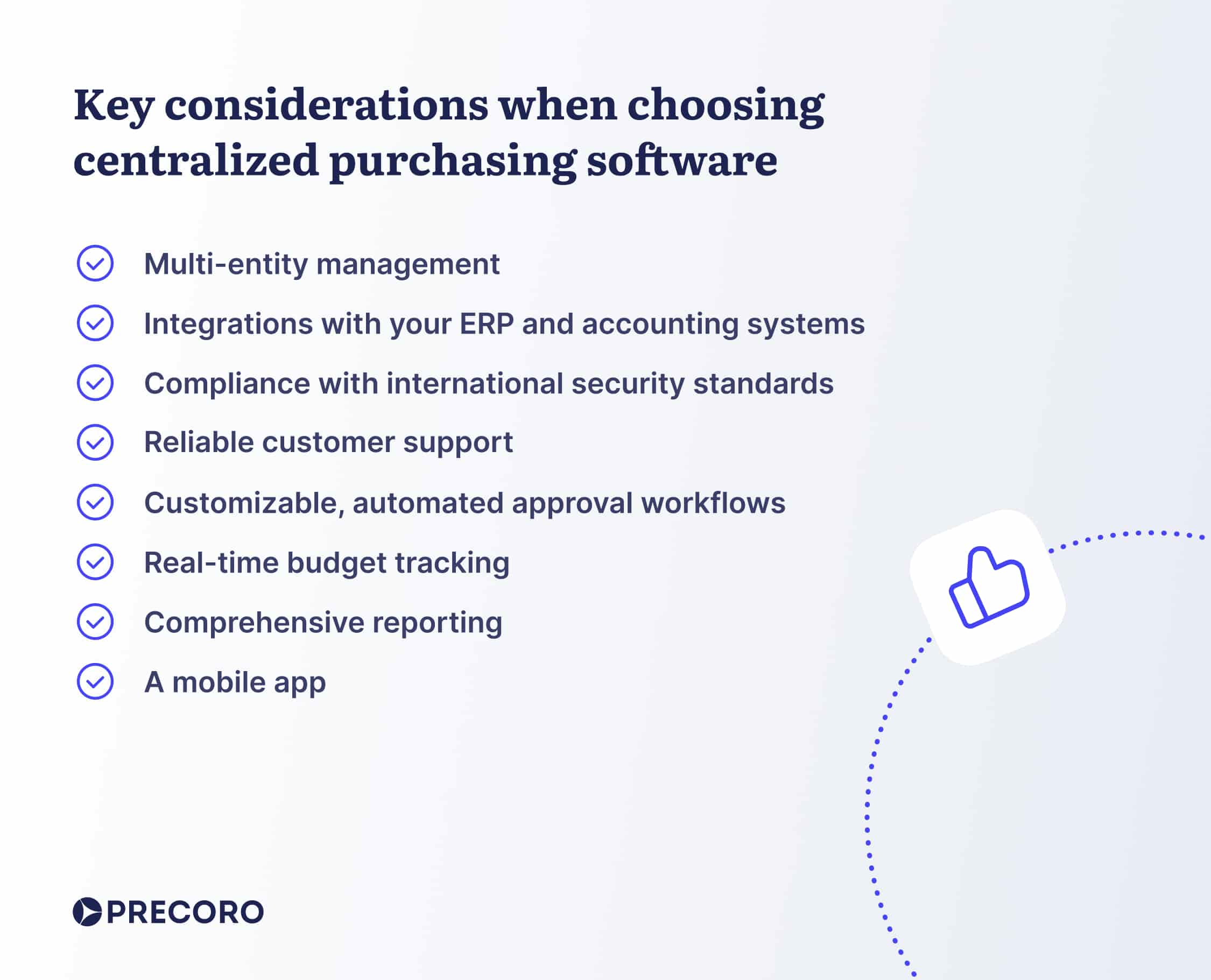
5. Roll it out in phases
Instead of flipping the switch across the whole company, start with one department or location to make the transition to a centralized procurement process smoother. This phased rollout lets you see what works and what might need tweaking without overwhelming everyone. Gather feedback from the team first using the new solution, address any issues that come up, and then gradually expand across the whole company. It’s a more manageable approach that helps you fine-tune the centralized purchasing system as you go.
Frequently Asked Questions
Centralized purchasing is a procurement model in which all buying activities across a company are handled by one central team, instead of each department or entity doing its own purchasing.
In a centralized procurement model, one procurement team handles purchasing for the entire organization, allowing for better spending control and compliance with the established procurement policy across locations. On the other hand, decentralized purchasing involves each department or entity managing its own buying process. This model can seem more flexible, but it also results in higher costs and less efficient buying.
Centralized purchasing brings a bunch of perks to the table. First, it helps companies save money by pooling buying power and getting better deals from suppliers. It also cuts down on duplicate orders, reduces paperwork, and makes spend tracking way easier. Plus, with one team managing everything, companies get better consistency, fewer mistakes, and stronger supplier relationships. When all entities and departments rely on one centralized procurement process, it’s easier to spot issues, track performance, and stay compliant.
Ready to reap the benefits of a centralized purchasing system?
Implementing a centralized procurement model is a great strategy for cost reduction, ensuring procurement compliance across all subsidiaries, and getting a better grip on spending. A centralized procurement organization structure is especially valuable for medium and large businesses with multiple entities and companies going through mergers.
For organizations with multiple branches, a centralized purchasing system keeps procurement practices consistent. Such a system eliminates the need for separate teams at each site, saving both time and money. Plus, a centralized procurement organization structure makes tracking compliance with company policies a whole lot easier. As the business grows, this approach only gets more useful — consolidating purchasing power to unlock better savings and smarter planning.
By pulling all your purchasing into one central team and using centralized procurement software, you’ll avoid duplicate orders, prevent overspending, and build stronger relationships with suppliers. On top of that, if you’re facing challenges like fraud, compliance issues, or supply chain disruptions, a centralized purchasing system will give you the control to address and resolve them effectively.
Take a closer look at your current processes, choose the right centralized purchasing software, and get ready to see improvements in efficiency and savings.


